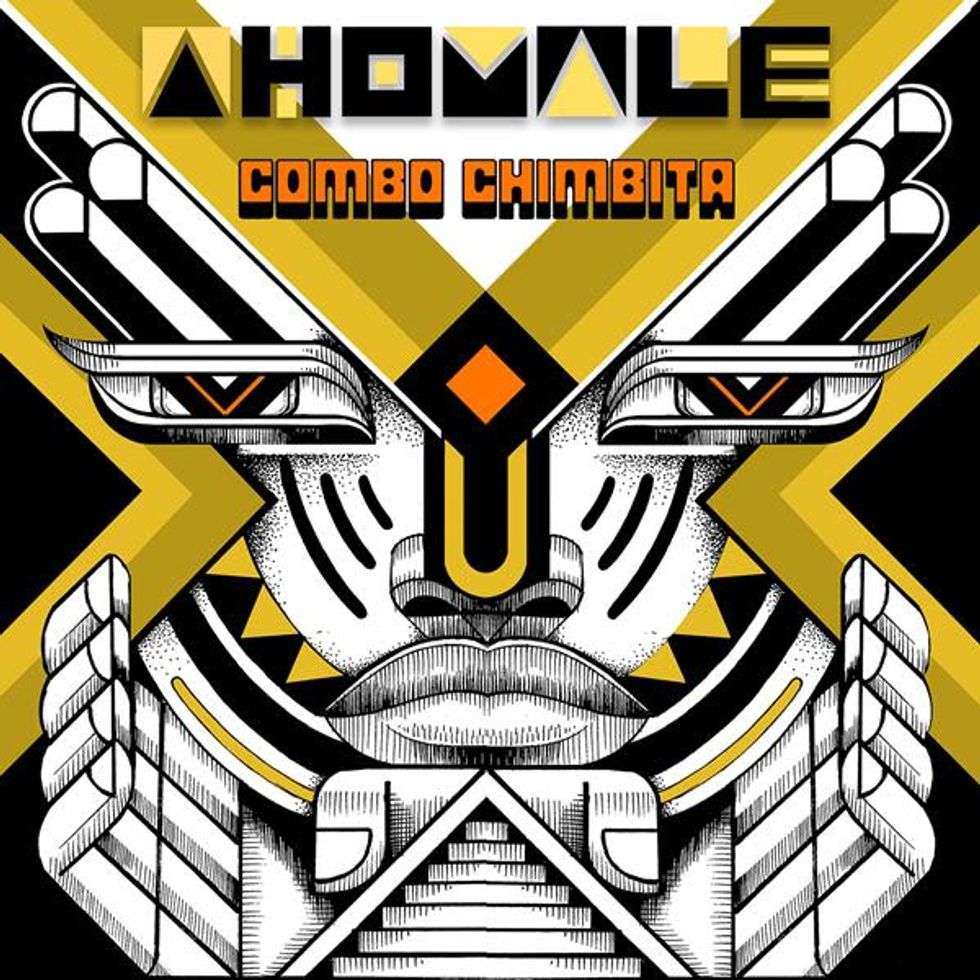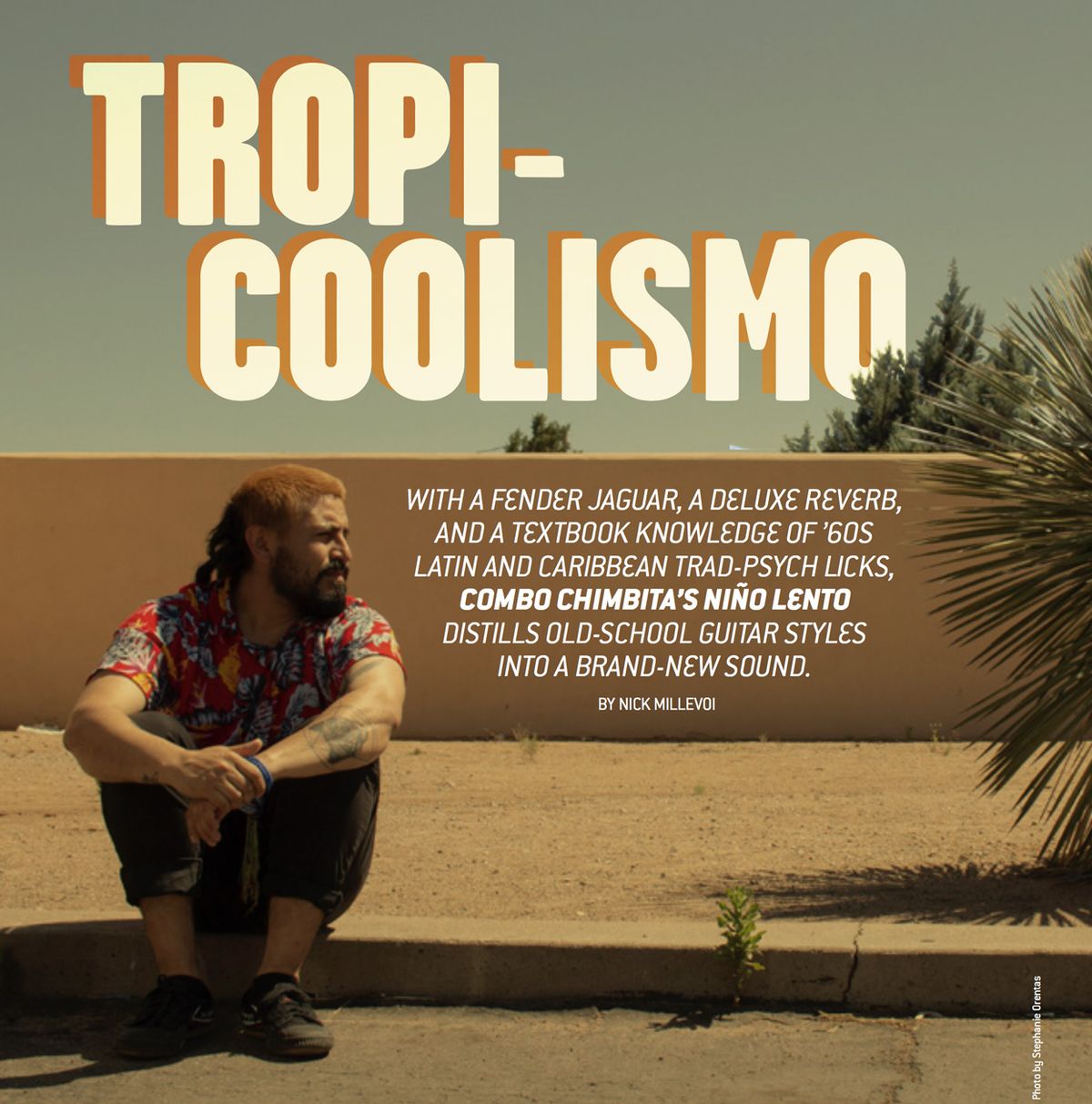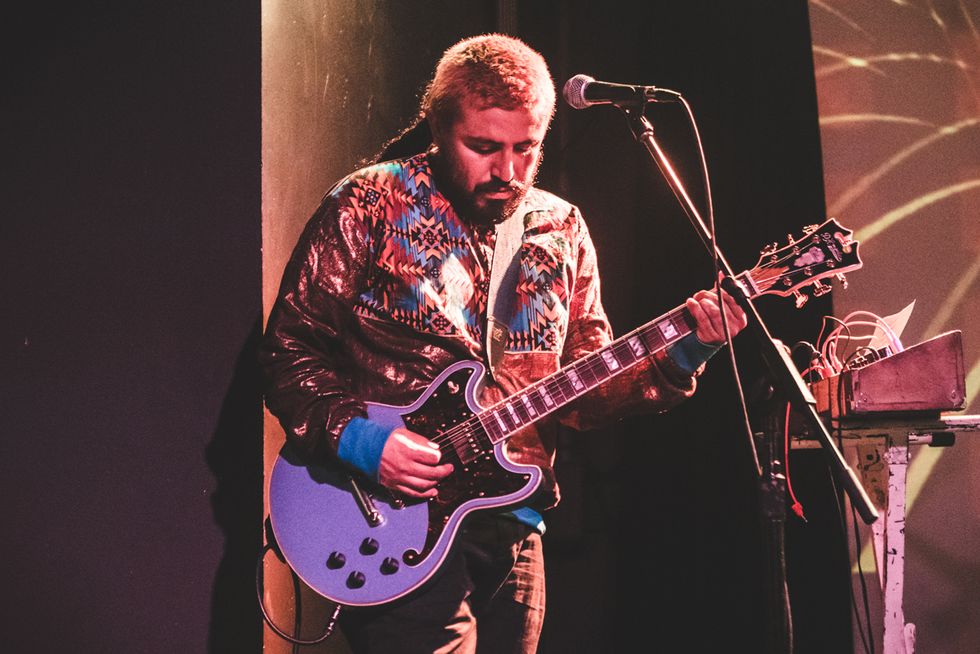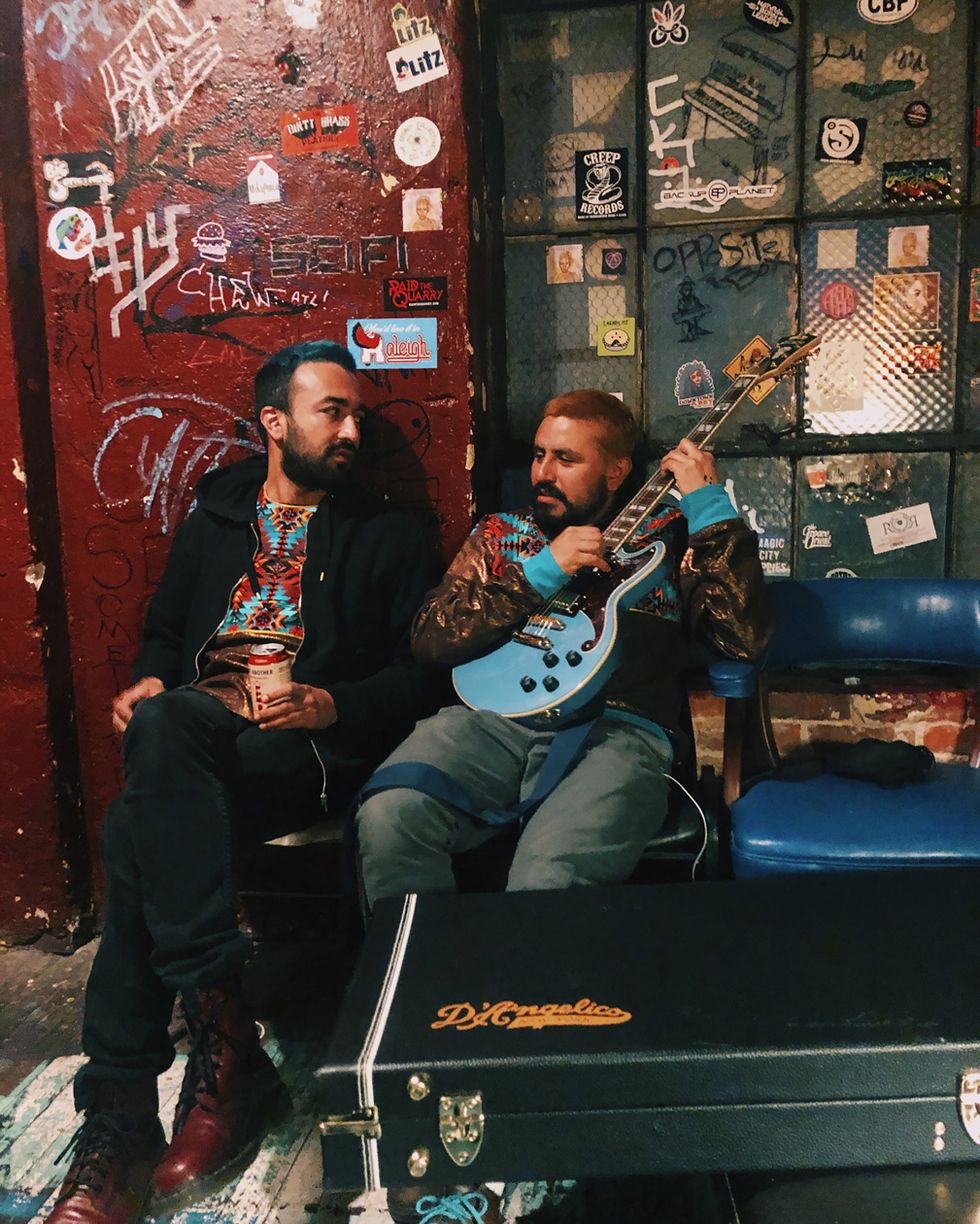With a textbook knowledge of ’60s trad-psych licks, the New York City-based guitarist distills old-school styles into a brand-new sound.
The opening of Combo Chimbita’s Ahomale sets a mystical tone. You can easily imagine a stage filled with fog as vocalist Carolina Oliveros belts out the reverb-soaked rubato melody of “Sola,” accompanied by a lone synthesizer. The mood changes as guitarist Niño Lento takes over the melody and, joined by the rhythm section, kicks into the groove of the title track. As the band hits the chorus, they rock out and Oliveros opens up, hitting long vibrato-laden notes with authority against Lento’s overdriven power chords.
In the first few minutes of Ahomale, the members of Combo Chimbita—four Colombian immigrants who met in a segment of the New York City music scene that encouraged sonic exploration—display the respect that they bring to the musical traditions they grew up around, but also show that they have their own ideas about how to create within that heritage. Self-described “tropical futurists,” they manage to use those traditions as a springboard for their forward-thinking exotic sound. Throughout Ahomale, they combine characteristics of South American and Caribbean music, such as Oliveros’ playing the palm-tree-trunk-derived guacharaca and Lento’s trance-inducing repetitive guitar ostinatos, with contemporary dance production and grooves, which are featured on “Brillo Más Que El Oro (La Bala Apuntándome),” and synth and distortion-heavy psychedelic rock, which is referenced in “Al Templo” and “Ahomale.”
Ahomale is the band’s second full-length release andwas helmed by rock producer Daniel Schlett (the War on Drugs, Modest Mouse). It follows a 2016 debut EP, El Corredor del Jaguar, and the album Abya Yala. While the group’s fusion of diverse musical approaches makes Ahomale a very atypical rock album, it is certainly an album that rocks. Combo Chimbita has shared stages with Parquet Courts, Buke & Gase, and Glass Animals, and finds a home among indie-rock audiences, who may be unfamiliar with the various musical dialects that the group assimilates, but are still able to identify with Combo Chimbita’s vibe and aesthetic.
The sinewy guitar lines that Lento spins on his Fender Jaguar lie at the center of Combo Chimbita’s sound. They also help his other band, the ultra-propulsive M.A.K.U. Soundsystem, percolate. Lento’s percussive riffing establishes the rhythmic backbone of the groove while weaving around the harmonic essentials of each song. Talking to Lento, it’s clear that his decisions about combining musical traditions are all intentional and well-informed. The guitarist has deep knowledge about Latin American and Caribbean music, and has undoubtedly spent a lot of time digging through record-store crates as part of his research.
His tone is reverent when discussing the role of the electric guitar in various traditions of Latin American music, from Colombian to Peruvian to Haitian, and he is humble about taking too much credit for his band’s influences. He makes sure to mention that many of his favorite musicians from older generations created their own sonic synthesis using keyboards and guitar effects to evoke their assimilation of psychedelia. And he’s just as knowledgeable when discussing the punk and metal inspirations of his youth.
We talked with Lento on the phone about Ahomale and to get an understanding of Combo Chimbita’s musical roots. That story intertwines with Lento’s tale of discovering the music that is important to him, and we ended up learning a thing or two about Latin American guitar traditions along the way.
When did you move to New York City?
When I was 16 or 17 years old, in the late ’90s.
What was your musical upbringing like in Colombia?
In Colombia, I was listening to a lot of metal, punk, and hip-hop. That’s what I was surrounded by—lots of local bands in the local hardcore punk scene. I was listening to Colombian music, cumbia and stuff like that, but I was not really into that music so much. When you are there, you are looking for the outside music.
Was it a lot of American bands?
Yeah. We were listening to Pantera, Sepultura—they’re from Brazil—Suicidal Tendencies, Metallica, stuff like that.
Your music has a lot of Colombian influences. What can you tell us about those?
When I moved to New York, I started looking for my own music. I was trying to find who I was, in New York City. I had friends from the Dominican Republic, and they had their own music. I had friends from Puerto Rico, from everywhere, and I’m from Colombia, so I thought, “Let’s listen to some stuff.” I started going deeper into Colombian music and I started listening to African music and the connections between Colombian and African music and the whole Caribbean and South America. Then I discovered the whole world.
The electric guitar in Latin America, the Caribbean, and Africa is really deep. We’re not exposed to that in America. I realized this and started buying records. So, I was discovering all of this music.

TIDBIT: Looking for an infusion of yet another outside influence, Combo Chimbita chose to work with rock producer Daniel Schlett for their new album.
I was exposed to this music through immigrants in New York. Like from Haiti, they have bands called jazz bands—they’re not what we call jazz—and compas [a style of Haitian dance music], things like that. They have crazy guitarists, crazy bands, crazy recordings. Chicha from Peru has amazing guitar players. Afrobeat, also. I was listening to all these things.
Are there specific guitar players in those styles that you were particularly listening to?
There’s a lot. Abelardo Carbon—he's from Colombia. He’s got a psychedelic, crazy sound. He has a very Colombian style, but he was also trying to imitate the African sound. He’s from a city called Barranquilla, where people were listening a lot to African music and the bands were trying to imitate the sounds they were hearing from Africa. People in Barranquilla know so much about African music.
Another is Julian Angulo. He had a band called Julian y Su Combo, which is crazy. Another guitar player is Che Benitez, who had a band called Peregoyo.
There are a lot of Haitian bands and musicians in New York City. The guitar player for Tabou Combo is Jean-Claude Jean, and there’s another band called DP Express from Haiti, and Les Difficiles de Pétion-Ville. The guitar player for that band is Robert Martino.
And some Peruvian bands: One is called Los Shapis and the guitarist is Jaime Moreira. And Los Wembler’s de Iquitos, and the guitar player is Elmer Alberto Sanchez.
It’s great to list all this music because there’s a part of the electric guitar history that has not been documented as disciplined and carefully as the American guitar music has been. Here, there’s a music industry, but there is also music that is not as strong in the music industry but is really, really deep.
When did you first start hearing this music? When you moved to New York City, or in Colombia?
This music was all popular music in Colombia. This is music I was hearing in the bar and at parties, but I was 15 or 16, and you don’t want to listen to your parents’ music or your grandparents’ music, so we were trying to listen to the cool things that were happening in the U.S. and that was how I got interested in the guitar. I wanted to play really loud and I wanted people to jump and do a mosh pit. So this music was there in Colombia, but I just didn’t care. After I moved to New York City, I joined a traditional music group and learned to play the drums, and that’s when I started listening to all these things.
When did you start playing guitar?
I started playing guitar when I was 14 years old. My friend and I would go to free music classes at the church. We learned three or four chords and started a punk band with just acoustic guitars and we started writing songs.
Niño Lento’s main guitar is a Fender Jaguar, but he recently acquired one of D’Angelico’s new 2019 models: the Deluxe Brighton. Photo by Farah Sosa
When did you meet the members of Combo Chimbita and your other band, M.A.K.U. Soundsystem?
The drummer [Dilemastronauta] and the bass player/synthesizer guy [Felipe Quiroz, aka Prince of Queens] from Combo … we’ve been playing together for 10 years and we were in both bands. The synth guy doesn’t play in M.A.K.U. anymore. The drummer and I also have another group playing traditional music, called Bulla en el Barrio. We play a rhythm called bullerengue music. We get together every Sunday in different parks and play, like church.
What was the concept behind Combo Chimbita when you formed the group?
I found a Tascam 388 recording machine, an 8-track, and I wanted to make some recordings, so I called Felipe. He’s a sound engineer, too. We did an experiment and put out a record by the label Names You Can Trust, and that was just a jam.
Names You Can Trust is two DJs who are really into Latin American and Caribbean sounds—psychedelia from the Caribbean, psychedelia from Africa, these things. They were doing a residency at a club called Barbès [in Brooklyn] and they would do a DJ set and then they would have a band, so they asked us if we wanted to play. We only had one song that we recorded and we never played live, so we said let’s go and just jam. We would go once a month and jam, and became Combo Chimbita, trying to improvise on tropical psychedelic sounds. Carolina [Oliveros], the singer, she moved to New York and started going to the jams, and then that was it and it became more like songs.
Listening through the Combo Chimbita discography, it sounds like Ahomale has more rock references than the others.
Yeah, definitely, it does. It just happened naturally. It’s the way the band has been writing. We used to listen to a lot of oldies—old music, different old recordings—but now we also listen to some trap and new afrobeat that’s really cool, and try to create with these influences.
How do you approach your guitar playing within Combo Chimbita?
I don’t only see guitar as a lead instrument. I like to have an approach that is more like percussion. I find this in a lot of music from Latin America and the Caribbean. The approach to the guitar is to have a very important rhythmic purpose: It has to make people dance, it has to connect with the drums. I try to play notes where they make sense, and blend with the drums and blend with the bass and add something in terms of harmony and melody, but what I really like is rhythm. That’s what I prioritize, that the guitar is adding something to make the rhythm more groovy. Like funk and soul and disco and boogie have this guitar that adds to the rhythm. That’s how I approach it.
Your main guitar is a Fender Jaguar, right?
For Combo, yeah. I also have a Fender Strat that I play with M.A.K.U. This Jaguar, I bought from a friend and he passed away about three months after I bought it from him. This guy played guitar in a band in Jackson Heights [a neighborhood in Queens, New York City], and he was a crazy guitar player. He did something to it and he told me he put new stuff on it and moved stuff, but I don’t know what he did. I’m not very tech savvy, so I don’t know.
It sounds like you use a pretty simple effects chain. I hear some delay and some distortion.
That’s basically it. I have leftover pedals from my friends. I bought these pedals more than 10 years ago from them. I have a wah that was given to me, a Cry Baby, and I have a RAT distortion, two digital delays from Boss—a DD-3 and a DD-5—and I have a Moog Ring Modulator that I use for some things. That’s the only one I bought new.

Guitars
Fender Jaguar
Fender Stratocaster
Amps
Fender Deluxe Reverb
Effects
Boss DD-3 Digital Delay
Boss DD-5 Digital Delay
Dunlop Cry Baby
Moog Moogerfooger MF-102 Ring Modulator
Pro Co RAT
Strings and Picks
.012—.056, no brand preference
Medium picks
What do you like for amps?
I have a Fender Deluxe, but I don’t bring my amp most of the time. I just use the amp that they have, because we’re not at that level. Hopefully one day.
A lot of the music you’ve mentioned as an influence is meant for dancing. How important is dancing to your music? Is Combo Chimbita a dance band?
We always think of that with Combo Chimbita. Before, I used to think that if people didn’t dance, then they were not liking it, so it was funny for me to see people just looking at me playing. I felt like something was wrong. But I’m getting used to that and I understand that not everybody has to move. They can just look at what you’re doing and enjoy it.
It’s important for me to see people dancing. It’s connecting to music. It makes you play different and do different things when you think about how people are reacting to the music.
Does Combo Chimbita play to different kinds of audiences? What’s the difference between playing for people who understand your influences and people who come to your music in other ways?
A lot of our friends are Latinx people, but we play a lot for Americans. We haven’t played in Latin America. We’ve been opening shows for bands like Parquet Courts and Glass Animals, and some of the people who see us think what we’re doing is really new and say, “Wow, I've never heard things like this,” “I never heard the guitar or synthesizer like that.” But people from Latin America, they get it and say, “You’re playing like what my grandfather used to listen to.” I’m surprised, because a lot of people who like Combo Chimbita are in their 20s, and we are inspired by music that came out in the ’70s and ’60s, so maybe they’ve listened to some of this from their grandparents. It has a new content because of the lyrics and how we present it, but we’ve seen people crying. I guess the music makes them connect with their ancestors, with the rhythm they recognize, and it’s like this person is coming back. It’s interesting. But for people that have never heard any of these bands, they might think this is new and weird, but they were playing crazy synthesizers in Africa and Colombia and Peru.
You’re reaching people on several levels, but to people who are aware of your influences, you can reach them on a really deep level.
I’m surprised this has happened, because we started just jamming and the name is kind of a joke. It’s not a really deep name! If we would have known, we would have come up with a deeper name.
What does the name mean?
“Combo,” like a group of people, and “chimbita” is like a little cool. It’s a word that’s used in the streets of Colombia. Not directly cool, just a little bit. Just a little cool combo.
The intensity escalates throughout this live version of Combo Chimbita's “Revelación (Candela),” from Ahomale. Singer Carolina Oliveros leads the way as synths whorl, lights flash, and the rhythm section digs in. Listen to the way Niño Lento’s slippery guitar riffs and Prince of Queens’ bass lines weave, taking the band to its psychedelic peak during the final section, from about 3:30-4:52.
The groundwork for Combo Chimbita was laid when bassist Prince of Queens, at left, and Lento played at a series of jams held at the club Barbès in Brooklyn. The addition of vocalist Carolina Oliveros completed the group's sound. Photo by Stephanie Orentas
Niño Lento’s Guitar Influences
Combo Chimbita’s guitarist draws on a wealth of Latin American and Caribbean influences. Get an earful of some of his favorite players:Abelardo Carbonó: The virtuosic Colombian guitarist is known as the godfather of the champeta style and his playing displays afrobeat and psychedelic influences.
Julian Angulo: The Columbian composer-guitarist often explores funk and soul foundations with his group, Julian y Su Combo.
Tabou Combo de Pétion-Ville: The Haitian compas band features guitarist Jean-Claude Jean, who has held the rhythm guitar chair since 1968.
Los Wembler’s de Iquitos: Started by guitarist Salomón Sánchez Saavedra in 1968, this Peruvian chicha band’s sound is packed with psychedelic wah-soaked vibes.




